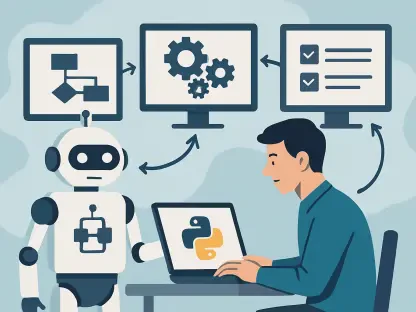Imagine a major e-commerce platform handling millions of transactions during a peak holiday sale, only to crash unexpectedly due to an undetected flaw in its infrastructure. Such failures can cost businesses millions in revenue and erode customer trust in an instant. This scenario underscores a critical challenge in modern IT environments: ensuring system resilience amid ever-growing complexity and unpredictability. Event-driven chaos engineering emerges as a transformative approach to address this issue, moving beyond traditional methods to test systems dynamically in real-time conditions. This review delves into the intricacies of this cutting-edge technology, exploring its principles, applications, and potential to redefine how organizations safeguard their digital ecosystems.
Understanding the Shift to Event-Driven Chaos Engineering
Chaos engineering, at its core, is a discipline focused on proactively identifying system vulnerabilities by intentionally inducing controlled failures. Historically, this practice relied on scheduled, manual fault injections to simulate disruptions and assess system behavior. However, as IT architectures have evolved into intricate webs of microservices, serverless functions, and event-streaming platforms, static testing has proven inadequate for capturing real-world complexities.
The transition to event-driven chaos engineering marks a significant leap forward. Unlike its predecessor, this methodology triggers experiments based on live system events—such as sudden traffic spikes or deployment changes—ensuring that tests mirror actual production scenarios. This shift is crucial for organizations aiming to maintain uptime and reliability in dynamic environments where traditional, pre-planned tests often miss critical edge cases.
This evolution aligns with the broader trend of adaptability in technology, reflecting a need for resilience strategies that keep pace with rapid innovation. By focusing on real-time responses, event-driven chaos engineering offers a more accurate lens through which to evaluate and strengthen system robustness, setting a new standard for reliability in distributed systems.
Core Features and Mechanisms of Event-Driven Chaos Engineering
Dynamic Fault Injection Triggered by Real-Time Events
A defining feature of event-driven chaos engineering is its ability to initiate fault injections in response to specific system occurrences. For instance, a test might activate when latency exceeds a predefined threshold or immediately following a new code deployment. This contextual relevance ensures that experiments reflect the conditions under which failures are most likely to occur, uncovering hidden issues that static tests might overlook.
Such dynamic triggering stands in stark contrast to the rigid schedules of traditional chaos engineering. By aligning with real operational changes, this approach reveals vulnerabilities tied to specific events—like integration errors during updates—providing actionable insights into system weaknesses. This precision enhances the effectiveness of resilience testing, making it a vital tool for modern IT teams.
Moreover, the ability to simulate failures under genuine production stressors allows organizations to build confidence in their systems’ capacity to withstand unexpected disruptions. This feature not only improves fault detection but also helps in crafting more robust recovery mechanisms tailored to real-world challenges.
Automation and Continuous Resilience Validation
Automation lies at the heart of event-driven chaos engineering, enabling seamless integration with CI/CD pipelines and observability platforms. By embedding chaos experiments into automated workflows, teams can conduct continuous testing without manual intervention, significantly speeding up feedback cycles for DevOps and Site Reliability Engineering professionals.
This automated approach supports the concept of chaos-as-code, where resilience tests are scripted, version-controlled, and repeatable. Such practices ensure consistency and scalability, allowing organizations to apply chaos engineering across diverse environments and teams. The result is a streamlined process that validates system stability on an ongoing basis, reducing the risk of undetected flaws.
Additionally, integration with real-time monitoring tools enhances the ability to analyze system responses during experiments. Metrics and logs collected in the moment provide a clear picture of how systems behave under stress, enabling rapid adjustments and fostering a culture of proactive improvement in resilience strategies.
Emerging Trends Shaping Chaos Engineering Practices
The rise of event-driven chaos engineering is part of a broader industry movement toward greater adaptability in resilience testing. As cloud-native systems become the norm, there is a noticeable push for methodologies that can handle the inherent dynamism of these architectures. This trend is evident in the increasing adoption of automated, event-responsive testing frameworks that prioritize real-time insights over periodic assessments.
Another significant development is the growing reliance on advanced observability to support chaos experiments. Tools that monitor metrics, traces, and logs in real time are becoming indispensable for triggering and evaluating tests, ensuring that organizations can detect and respond to anomalies as they occur. This synergy between observability and chaos engineering is redefining how system health is measured and maintained.
Culturally, there is a shift toward viewing controlled failures as valuable learning opportunities rather than setbacks. This mindset, coupled with technological advancements, is paving the way for broader acceptance of chaos engineering as a standard practice, promising a future where systems are not just resilient but truly antifragile—capable of thriving amid disruption.
Real-World Impact and Applications
Event-driven chaos engineering has found practical application across various sectors, demonstrating its versatility in enhancing system reliability. In the e-commerce industry, platforms leverage this technology to test resilience during high-traffic events like Black Friday sales, simulating failures during peak loads to ensure seamless user experiences even under strain.
In the financial sector, institutions use event-driven approaches to validate system stability during critical operations, such as real-time transaction processing or market fluctuations. By triggering experiments in response to sudden spikes in activity, these organizations can identify potential points of failure and bolster their infrastructure to prevent costly downtimes.
Streaming services also benefit significantly, employing this methodology to maintain uninterrupted content delivery during major releases or live events. Unique implementations, such as testing failover mechanisms during sudden server outages, highlight how event-driven chaos engineering improves fault detection and recovery, ensuring that end users face minimal disruptions in service.
Challenges in Implementation and Mitigation Strategies
Despite its advantages, adopting event-driven chaos engineering presents notable hurdles, particularly in configuring dynamic triggers that accurately reflect production conditions. Misaligned or overly sensitive triggers can lead to irrelevant tests or unnecessary disruptions, underscoring the need for precise calibration and robust observability to inform trigger design.
Testing in live production environments poses another challenge, carrying inherent risks of impacting real users if experiments go awry. To address this, strategies like limiting the blast radius—confining the scope of impact to specific components—and employing safety mechanisms such as circuit breakers and feature flags are essential. These controls help minimize potential damage while still allowing for meaningful testing.
Furthermore, the complexity of integrating chaos experiments with existing systems can deter adoption. Organizations can overcome this by starting with small, non-critical services to build expertise and confidence before scaling to more vital components. Such a phased approach, combined with comprehensive monitoring, ensures safer experimentation and smoother implementation.
Future Prospects and Innovations
Looking ahead, event-driven chaos engineering is poised for significant advancements, particularly through deeper integration with AI-driven anomaly detection. Such innovations could enable systems to predict and simulate failures before they occur, further enhancing proactive resilience and reducing the likelihood of unexpected outages.
Broader adoption across industries is also anticipated, as more organizations recognize the value of dynamic testing in maintaining competitive advantage. From healthcare to gaming, sectors with high stakes for system uptime are likely to embrace this technology, driving further refinement and customization of chaos engineering practices.
The long-term impact could be the widespread development of antifragile systems—architectures that not only withstand chaos but grow stronger from it. As tools and methodologies evolve over the coming years, event-driven chaos engineering may become a cornerstone of IT strategy, fundamentally reshaping how resilience is approached in an increasingly uncertain digital landscape.
Final Reflections on Event-Driven Chaos Engineering
Reflecting on the exploration of event-driven chaos engineering, it is clear that this technology marks a pivotal advancement in the quest for system resilience. Its ability to adaptively test systems under real-world conditions stands out as a superior alternative to traditional methods, offering unparalleled insights into potential vulnerabilities. The journey through its features, applications, and challenges reveals a toolset that, while complex to implement, delivers transformative benefits when executed with care.
For organizations looking to harness this potential, the next steps involve starting with controlled, small-scale experiments to build familiarity and mitigate risks. Investing in robust observability platforms is also critical, as these systems provide the foundation for effective trigger design and real-time analysis. Additionally, fostering a culture that embraces failure as a pathway to improvement proves essential for sustaining long-term adoption.
As the digital realm continues to evolve, exploring partnerships with technology providers to access cutting-edge tools and expertise becomes a strategic move. By prioritizing incremental progress and safety mechanisms, businesses can position themselves to not only survive disruptions but to leverage them as opportunities for growth, ensuring enduring stability in an unpredictable technological era.









